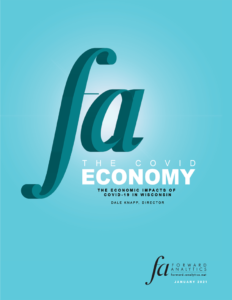The COVID Economy: The Economic Impacts of COVID-19 in Wisconsin

Despite the largest federal stimulus package in history, the economic fallout from the COVID-19 pandemic has been significant. A new report from Forward Analytics, The COVID Economy: The Economic Impacts of COVID-19 in Wisconsin, examines the economic damage wrought by the pandemic in Wisconsin from March through November 2020.
“Wisconsin, like the rest of our nation, has been battered from all directions by COVID-19,” said Forward Analytics Director Dale Knapp. “This latest report quantifies the impact it has had on workers and businesses, including loss of jobs, reductions in GDP, the closing of small businesses, and increased household reliance on the FoodShare program.”
The hit to Wisconsin’s economy in the first half of 2020, particularly during March through May, was enormous. Wisconsin’s gross domestic product (GDP) fell 11.4%. From mid-March through late-April, more than 440,000 Wisconsinites filed new unemployment claims. That number was 15.6% of those employed in February. The state’s official unemployment rate soared from 3.5% in February to 13.6% in April, the highest it has been since the Great Depression.
Federal assistance helped lessen the economic damage. The Coronavirus Aid, Relief, and Economic Security (CARES) Act injected nearly $20 billion into the state economy via $1,200 cash payments to individuals, $600 per week of additional unemployment benefits, and forgivable loans to small businesses designed to keep workers on the payroll. Without that federal help, Wisconsin’s total personal income would have declined significantly in the second quarter. Instead, it rose 8%.
According to Knapp, who authored the Forward Analytics report, the sharp economic decline was short-lived as employers began rehiring significant numbers of workers in May and June. However, the pace of job gains slowed during July through September and employment declined in October and November. As of November, the number of jobs in Wisconsin stood 7.6% below February employment. At that level, the state has a long road ahead before the economy returns to pre-pandemic levels.
The unemployment rate confirms the slowing of the recovery. By November, the rate had fallen to 5.0%. However, that was well above the 3.5% rate in February.
“While nearly all industries have been affected by the pandemic, the accommodation and food service industry and the arts and entertainment industry were hardest hit,” said Knapp. “As of November, employment was 25% below February levels in hotels, restaurants, and bars and 36% below February levels in the arts and entertainment industry.”
Small businesses were particularly hard hit. Figures from researchers at Harvard University show that in November, the number of small businesses open was 30% less than in January. A November survey showed that 37% of Wisconsin restaurant operators felt they would be out of business in six months without federal help.
Knapp continued, “Looking to 2021, there are reasons to be hopeful and reasons to be cautious. The recently passed federal stimulus bill provides some assistance for struggling businesses. The bill also funds an additional $300 per week of unemployment compensation through mid-March, helping the unemployed. Moreover, a rollout of a vaccine creates hope of a near-term return to normal.”
He added this caveat, “However, recently discovered mutations of the COVID virus in Great Britain and South Africa are significantly more contagious than the original virus. In just under a month from the date the British strain was identified in mid-December, cases there more than tripled. Should those strains take hold in the United States, cases could spike in late winter or early spring and further stall economic recovery.”
